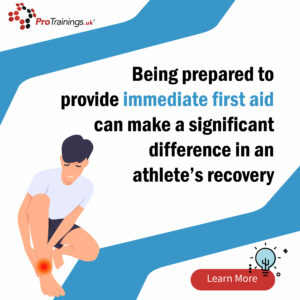First Aid for Sports Injuries: A Coach’s Guide

As a coach, ensuring the safety of your athletes is a top priority. Sports injuries are common, and being prepared to provide immediate first aid can make a significant difference in an athlete’s recovery. This guide provides essential first aid tips for common sports injuries, helping you respond quickly and effectively when accidents happen on the field, court, or track. You can learn more by completing a Sports First Aid training course that can be completed face to face or on video online training.
1. Sprains and Strains
Sprains and strains are among the most common sports injuries, often occurring when ligaments or muscles are overstretched or torn:
- Symptoms: Pain, swelling, bruising, and limited movement in the affected area.
- Treatment: Follow the R.I.C.E. method:
- Rest: Encourage the athlete to stop the activity and rest the injured area.
- Ice: Apply ice to the injury for 15-20 minutes every 2-3 hours to reduce swelling but not in direct contact with the skin.
- Compression: Wrap the injured area with an elastic bandage to provide support and reduce swelling.
- Elevation: Elevate the injured limb above heart level to help reduce swelling.
- When to Seek Medical Help: If the pain is severe, if the athlete cannot bear weight on the affected limb, or if there is no improvement after a few days, refer them to a healthcare professional.
2. Fractures and Dislocations
Fractures (broken bones) and dislocations (joints forced out of position) require immediate attention:
- Symptoms: Intense pain, swelling, deformity, and inability to move the affected limb.
- Treatment:
- Immobilise: Keep the injured limb as still as possible to prevent further damage. Use a splint or sling if available.
- Do Not Reposition: Never attempt to realign a dislocation or fracture.
- Cold Compress: Apply a cold pack to the area to reduce swelling.
- Emergency Help: Call 999 or get the athlete to the nearest A&E department immediately.
- Post-Incident Care: Ensure the athlete receives a thorough medical evaluation and follows the recommended recovery plan.
3. Concussions
Concussions are a serious concern in sports, especially in contact sports like football or rugby:
- Symptoms: Headache, confusion, dizziness, nausea, sensitivity to light, memory problems, and loss of consciousness.
- Treatment:
- Immediate Rest: Remove the athlete from play immediately if a concussion is suspected.
- Monitor Symptoms: Keep a close watch on their symptoms, as some may worsen over time.
- Seek Medical Attention: All suspected concussions require medical evaluation. The athlete should not return to play until cleared by a healthcare professional.
- Gradual Return: Follow a step-by-step return-to-play protocol, ensuring the athlete is symptom-free at each stage before progressing.
4. Cuts and Abrasions
Cuts and abrasions are common in sports, particularly in outdoor activities:
- Treatment:
- Clean the Wound: Rinse the area with clean water to remove dirt and debris.
- Apply Antiseptic: Use an antiseptic wipe or solution to disinfect the wound.
- Dress the Wound: Cover the wound with a sterile dressing or plaster to protect it from infection.
- Monitor for Infection: Keep an eye out for signs of infection, such as increased redness, swelling, or pus. If these occur, seek medical advice.
5. Heat Exhaustion and Heatstroke
Athletes exerting themselves in hot weather are at risk of heat exhaustion and heatstroke:
- Symptoms of Heat Exhaustion: Heavy sweating, weakness, dizziness, nausea, and headache.
- Symptoms of Heatstroke: High body temperature, confusion, rapid pulse, and loss of consciousness.
- Treatment for Heat Exhaustion:
- Move to a Cool Area: Get the athlete to a shaded or air-conditioned place.
- Hydrate: Encourage them to drink water or a sports drink to replenish fluids.
- Cool Down: Use cool cloths or a cold bath to lower their body temperature.
- Treatment for Heatstroke: Heatstroke is a medical emergency. Call 999 immediately. While waiting for help, cool the athlete with any available means (e.g., cold water, fans).
6. Muscle Cramps
Muscle cramps are painful involuntary contractions often caused by dehydration, overuse, or electrolyte imbalance:
- Treatment:
- Stretching: Gently stretch and massage the affected muscle to relieve the cramp.
- Hydration: Encourage the athlete to drink water or a sports drink to rehydrate and replenish electrolytes.
- Rest: Allow the athlete to rest and recover before resuming activity.
7. Eye Injuries
Eye injuries can occur from impact with a ball, another player, or equipment:
-
- Symptoms: Pain, redness, blurred vision, and swelling.
- Treatment:
- Do Not Rub: Advise the athlete not to rub their eye, as this can cause further damage.
- Flush the Eye: If debris is in the eye, rinse it gently with clean water or saline solution.
- Cover and Seek Help: If the injury is severe, cover the eye with a clean cloth and seek medical attention immediately.
Conclusion
As a coach, having first aid knowledge is crucial for managing sports injuries effectively. By understanding how to respond to common injuries, you can help your athletes recover safely and return to their sport with confidence. Consider keeping a well-stocked first aid kit on hand during practices and games, and regularly update your first aid training to stay prepared for any situation.
For more information on courses, visit Sports First Aid Training Course | Sports & FA First Aid Course (prosportsfirstaid.co.uk)
Visit www.first-aid-online.co.uk today for top-quality first aid equipment you can trust!
